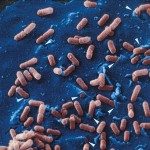Lien vers Pubmed [PMID] – 11207576
Cell. Microbiol. 2000 Jun;2(3):195-205
Bacterial actin-based motility has provided cell biologists with tools that led to the recent discovery that, in many forms of actin-based motilities, a key player is a protein complex named the Arp2/3 complex. The Arp2/3 complex is evolutionally conserved and made up of seven polypeptides involved in both actin filament nucleation and organization. Interestingly, this complex is inactive by itself and recent work has highlighted the fact that its activation is achieved differently in the different types of actin-based motilities, including the well-known examples of Listeria and Shigella motilities. Proteins of the WASP family and small G-proteins are involved in most cases. It is interesting that bacteria bypass or mimic some of the events occurring in eukaryotic systems. The Shigella protein IcsA recruits N-WASP and activates it in a Cdc42-like fashion. This activation leads to Arp2/3 complex recruitment, activation of the complex and ultimately actin polymerization and movement. The Listeria ActA protein activates Arp2/3 directly and, thus, seems to mimic proteins of the WASP family. A breakthrough in the field is the recent reconstitution of the actin-based motilities of Listeria and N-WASP-coated E. coli (IcsA) using a restricted number of purified cellular proteins including F-actin, the Arp2/3 complex, actin depolymerizing factor (ADF or cofilin) and capping protein. The movement was more effective upon addition of profilin, alpha-actinin and VASP (for Listeria). Bacterial actin-based motility is now one of the best-documented examples of the exploitation of mammalian cell machineries by bacterial pathogens.

